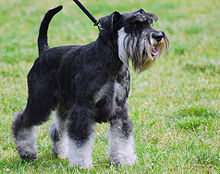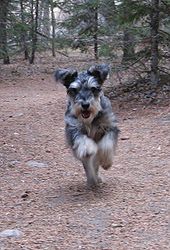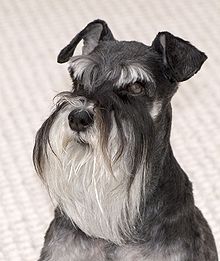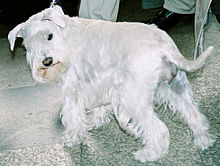- Miniature Schnauzer
-
Miniature Schnauzer 
Classic pose of a Miniature Schnauzer. This dog has a natural (stripped) salt and pepper coat, natural ears and docked tail. Other names Zwergschnauzer (Dwarf Schnauzer) Country of origin Germany Traits Weight Male 12 to 20 lb (5.4 to 9.1 kg) Female 12 to 18 lb (5.4 to 8.2 kg) Height Male 12 to 14 in (30 to 36 cm) Female 12 to 14 in (30 to 36 cm) Coat Harsh and wiry when hand stripped, soft and curly when unclipped Color Black, salt-and-pepper, black-and-silver and white Litter size 3 to 8 pups Life span 12 to 15 years Classification and standards FCI Group 2 Section 1 #183 standard AKC Terrier standard ANKC Group 6 (Utility) standard CKC Group 4 - Terriers standard KC (UK) Utility standard NZKC Utility standard UKC Terriers standard Dog (Canis lupus familiaris) The Miniature Schnauzer is a breed of small dog of the Schnauzer type that originated in Germany in the mid-to-late 19th century. Miniature Schnauzers developed from crosses between the Standard Schnauzer and one or more smaller breeds such as the Poodle and Affenpinscher.[1]
The breed remains one of the most popular world wide, primarily for its temperament and relatively small size. Globally, the Miniature Schnauzer comes in four colors: black, salt-and-pepper, black-and-silver, and white. As of 2008 it is the 11th most popular breed in the U.S.[2]
Contents
Appearance
Miniature Schnauzers have a squarely proportioned build, measuring 12 to 14 inches (30 to 36 cm) tall and weighing 11 to 15 pounds (5.0 to 6.8 kg) for females and 14 to 18 pounds (6.4 to 8.2 kg) for males. They have a double coat. The exterior fur is wiry and the undercoat is soft. The coat is kept short on the body, but the hair on ears, legs, and belly are retained.
Miniature Schnauzers are often described as non-shedding dogs, and while this is not entirely true, their shedding is minimal and generally unnoticeable. They are characterized by a rectangular head with bushy beard, mustache and eyebrows; teeth that meet in a "scissor bite"; oval and dark colored eyes; and v-shaped, natural forward-folding ears. (When cropped, the ears point straight upward and come to a sharp point.) Their tails are naturally thin and short, and may be docked (where permitted). They will also have very straight, rigid front legs, and feet that are short and round (so-called "cat feet") with thick, black pads.[3][4]
Temperament
The Official Standard of the Miniature Schnauzer for the American Kennel Club describes temperament as "alert and spirited, yet obedient to command...friendly, intelligent and willing to please...should never be overaggressive or timid."[3] Usually easy to train, they tend to be excellent watchdogs with a good territorial instinct, but more inclined toward barking than biting. They are often aloof with strangers until the owners of the home welcome the guest, upon which they are typically very friendly to them.[5] However, they will often express themselves vocally, and may bark to greet their owner, or to express joy, excitement, or displeasure.
Proper socialization with other dogs and people is important.[6][7][8] The breed is generally good with children, but as with any dog, play with small children should be supervised. They are highly playful dogs, and if not given the outlet required for their energy they can become bored and invent their own "fun." Miniature Schnauzers can compete in dog agility trials, obedience, showmanship, flyball, and tracking. Schnauzers have a "high prey drive" (appropriate for a ratting dog), which means they may attack other small pets such as birds, snakes, and rodents. Many will also attack cats, but this may be curbed with training, or if the dog is raised with cats.[3]
History
The earliest records surrounding development of the Standard Schnauzer (or Mittelschnauzer) in Germany come from the late 19th century. They were originally bred to be medium-sized farm dogs in Germany, equally suited to ratting, herding, and guarding property and children.[citation needed] As time passed, farmers bred down the Standard Schnauzer into a smaller, more compact size perfect for ratting around the house and barn.[citation needed] Several small breeds were employed in crosses to bring down the size of the well-established Standard Schnauzer, with the goal of creating a duplicate in miniature.[citation needed]
Recognition
The first recorded Miniature Schnauzer appeared in 1888, and the first exhibition was held in 1899.[who?] The AKC accepted registration of the new breed in 1926, two years after Miniature Schnauzers were introduced to the United States.[3] The AKC groups this breed with the Terriers, because it was developed for a similar purpose and has a similar character to the terrier breeds of the Britain and Ireland, but because the Miniature Schnauzer was bred to be a ratter, and not used to 'go to ground' like British terriers, it is more correctly termed a Pinscher ("biter", a descriptive word like "setter" or "retriever").
The Miniature Schnauzer was recognized by the United Kennel Club in 1948 and originally also grouped the breed as a terrier. For reasons mentioned above, the United Kennel Club now lists the Miniature Schnauzer in the Utility group for shows run under the UK Kennel Club rules such as Crufts.[citation needed]
The World Canine Organization also does not list the Miniature Schnauzer as a terrier.[citation needed]
Health and grooming
While generally a healthy breed, Miniature Schnauzers may suffer health problems associated with high fat levels. Such problems include hyperlipidemia, which may increase the possibility of pancreatitis, though either may form independently. Other issues which may affect this breed are diabetes, bladder stones and eye problems. Feeding the dog low- or non-fatty and unsweetened foods may help avoid these problems.[9][10][11] Miniature Schnauzers are also prone to comedone syndrome, a condition that produces pus filled bumps, usually on their backs, which can be treated with a variety of protocols.[12] Miniature Schnauzers should have their ears dried after swimming due to a risk of infection, especially those with uncropped ears; ear examinations should be part of the regular annual check up.[13]
The other two common diseases observed in Miniature Schnauzers are hip dysplasia and von Willebrand disease (vWD).[14] vWD in dogs is an inherited bleeding disorder that occurs due to qualitative or quantitative deficiency of von Willebrand factor (vWF), a multimeric protein that is required for platelet adhesion.
Schnauzers have a specific groom cut that is standard among the Schnauzer breed. Schnauzers require regular grooming, either by stripping (mostly seen in show dogs), or by clipping (a short-cut usually reserved for family pets). Stripping removes the loose, dead coat; it may be done by hand, called finger stripping, or plucking, or with a stripping knife; either way, it is a laborious process. Many Miniature Schnauzers who are family pets have regular grooming appointments to have their hair clipped; clipping, using a mechanical clippers (or shaver), produces a soft, silky, skin-close trim. Whether stripped or clipped, the coat is close at the body, and falls into a fringe-like foundation on their undercarriage, called furnishings, which can be left to grow, but must be combed regularly. All Schnauzers, whether they are minis, Standards, or Giants, often sport a beard, created by allowing the hair around their noses to grow out. Left unclipped or unstripped, the body hair will grow two to four inches, and will often tangle into mats and curls.[15]
North American white Schnauzer controversy
The white Schnauzer is one of four color varieties of the Miniature Schnauzer currently recognized by the Pinscher-Schnauzer Klub of Germany and the World Canine Organization. However, they are not accepted by the breed clubs of two countries; the American Kennel Club and Canadian Kennel Club for conformation showing (though they can be registered and show in performance events). The controversy rests on the disputed origins of the white variation.
Disputed origins of white Miniature Schnauzers
From pedigree research, the "white" (gelb or "yellow" as it was called in early German records) gene was introduced into the Miniature Schnauzer breed mainly through a German black Champion Miniature Schnauzer named Peter V Westerberg (PZ604), born in November 1902.[citation needed] Peter carried the white "e" gene and was bred to a female named Gretel VD Werneburg (PZ1530) (color unknown) and produced a "yellow" female pup named Mucki VD Werneburg (PSZ 8) born October 1914. Mucki was bred to a grandson of Peter named Pucki VD Werneburg, a dark salt and pepper (PSZ12), who produced the black German Champion Peterle VD Werneburg (PSZ11) born June 2, 1916, who also carried the white "e" gene because his dam was yellow. Peter V Westerburg or his grandson, Peterle, can be traced to nearly every Miniature Schnauzer line researched in AKC records. For example, every ancestor in the 5th generation of Dorem Display[clarification needed] goes back to Peter V Westerberg.
There is no known factual data to back up the assertion that gelb is equal to white; however, white Miniature Schnauzers with harsh, stripped coats will have a yellowish streak on their backs and head.
Coat color inheritance
Recently, unrelated white Miniature Schnauzers from around the world were DNA typed for color, showing the genotype for a white Miniature Schnauzer is "e/e" at MC1r (commonly referred to as the "E" locus), proving white Miniature Schnauzers are not albinos. Their skin and eye color are normal, although some white dogs appear to show reduced pigment on the nose, especially in winter (snow nose).
This "e,e" genotype for the white Miniature Schnauzer proves that any of the other three colors can carry a gene for the white, and that any dog carrying for white, if bred to another carrier, could produce a white puppy. However, it does not answer the question of whether the "e" gene in modern white Miniature Schnauzers has been preserved since the origin of the breed or if, as some claim, it was artificially inserted into the breed by cross-breed matings at some point in time. Either or both could be true.
See also
References
- ^ "Miniature Schnauzer History". AKC.org. http://www.akc.org/breeds/miniature_schnauzer/history.cfm. Retrieved 2008-08-22.
- ^ "AKC Dog Registration Statistics". AKC.org. 2008. http://www.akc.org/reg/dogreg_stats.cfm. Retrieved 2009-02-28.
- ^ a b c d "Miniature Schnauzer Breed Standard". AKC.org. http://www.akc.org/breeds/miniature_schnauzer. Retrieved 2008-06-25.
- ^ "Dogs That Do Not Shed". GoPetsAmerica.com. http://www.gopetsamerica.com/dogs/dogs-that-do-not-shed.aspx. Retrieved 2008-09-18.
- ^ Kiedrowski, Dan (1997). The New Miniature Schnauzer (2nd edition ed.). New York: Howell Book House. pp. 12. ISBN 0876052413. OCLC 36170497.
- ^ "Know Your Mini Schnauzer". http://www.dogbreedinfo.com/miniatureschnauzer.htm.
- ^ "Know Your Mini Schnauzer". http://miniatureschnauzer.ca/breedinfo.htm.
- ^ "Know your MiniSchnauzer Puppy". http://www.yourpurebredpuppy.com/reviews/miniatureschnauzers.html.
- ^ "Miniature Schnauzer Breed Info - Health Issues". MiniatureSchnauzer.ca. http://miniatureschnauzer.ca/breedinfo.htm#health. Retrieved 2008-06-25.[dead link]
- ^ "Pet Care Library". Healthypet.com. http://www.healthypet.com/library_view.aspx?ID=167&sid=1. Retrieved 2008-06-25.
- ^ "Canine hyperlipidemia". Weir.net. 2003-02-13. http://www.weir.net/~lglass/canine-hyperlipidemia.htm. Retrieved 2008-06-25.
- ^ "Schnauzer Comedone Syndrome". 2009 VetInfo.. http://www.vetinfo.com/dencyclopedia/desnzcomd.html. Retrieved 2009-06-01.
- ^ "Miniature Schnauzers - Grooming". TerrificPets.com. http://www.terrificpets.com/dog_breeds/miniature_schnauzer.asp. Retrieved 2008-06-25.
- ^ Miniature Schnauzer Health, Dog-breeds.in
- ^ "Grooming your Miniature Schnauzer". The American Miniature Schnauzer Club. 2006-08-17. http://amsc.us/index.php?option=com_content&task=view&id=16&Itemid=33. Retrieved 2009-06-01.
External links
Terriers by FCI section Large and medium-sized Terriers Airedale Terrier · Bedlington Terrier · Border Terrier · Brazilian Terrier · Fox Terrier (Smooth) · Fox Terrier (Wire) · Glen of Imaal Terrier · Irish Terrier · Jagdterrier · Kerry Blue Terrier · Lakeland Terrier · Manchester Terrier · Parson Russell Terrier · Soft-Coated Wheaten Terrier · Welsh TerrierSmall-sized Terriers Bull type Terriers Toy Terriers Not categorized by FCI as Terrier
(in another group or not recognised)American Hairless Terrier · American Pit Bull Terrier · Black Russian Terrier · Boston Terrier · Dutch Smoushond · Miniature Fox Terrier · Old English Terrier · Patterdale Terrier · Plummer Terrier · Rat Terrier · Ratonero Bodeguero Andaluz · Russkiy Toy · Sporting Lucas Terrier · Teddy Roosevelt Terrier · Tenterfield Terrier · Tibetan Terrier · Toy Fox Terrier · Toy Manchester TerrierToy dogs Affenpinscher · Australian Silky Terrier · Bichon Frisé · Bolognese · Boston Terrier · Cavalier King Charles Spaniel · Chihuahua · Chinese Crested Dog · Coton de Tulear · Damchi · English Toy Terrier · Griffon Bruxellois · Havanese · Italian Greyhound · Japanese Chin · King Charles Spaniel · Löwchen · Maltese · Miniature Pinscher · Miniature Poodle · Miniature Schnauzer · Papillon · Pekingese · Pomeranian · Pug · Russkiy Toy · Shih Tzu · Toy Manchester Terrier · Toy Poodle · Yorkshire TerrierCategories:- Terriers
- Toy dogs
- Dog breeds originating in Germany
Wikimedia Foundation. 2010.




